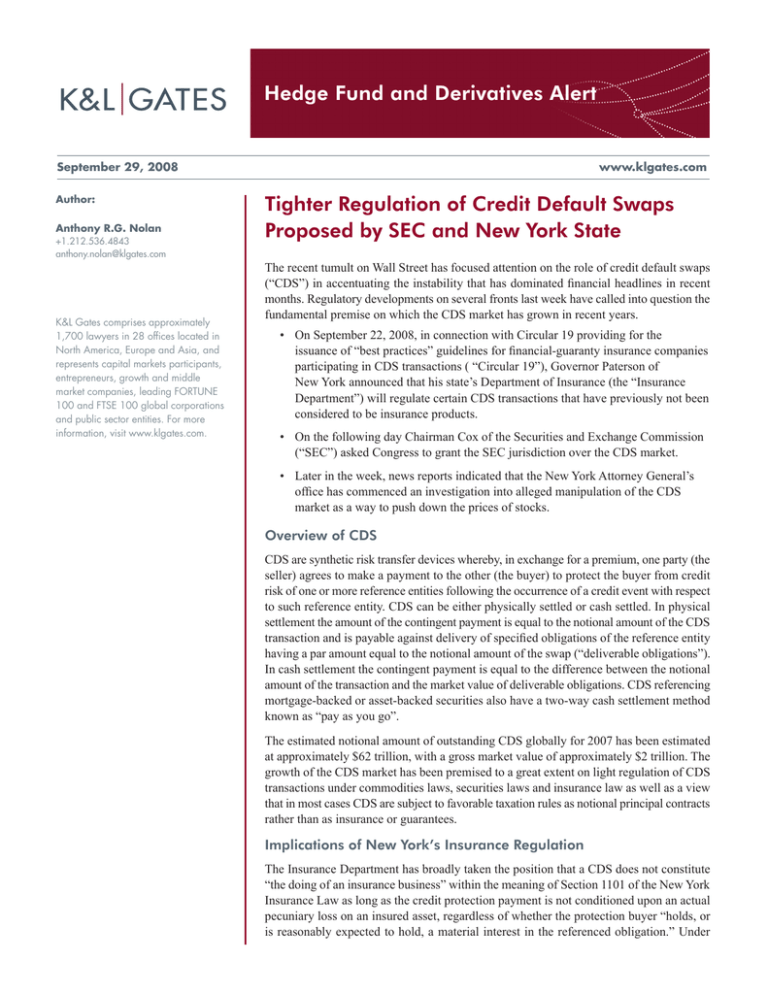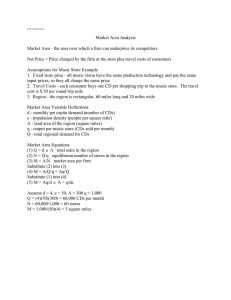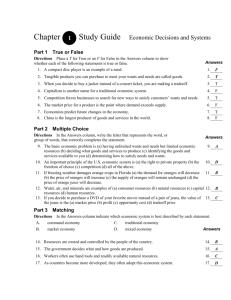
Hedge Fund and Derivatives Alert
September 29, 2008
Author:
Anthony R.G. Nolan
+1.212.536.4843
anthony.nolan@klgates.com
K&L Gates comprises approximately
1,700 lawyers in 28 offices located in
North America, Europe and Asia, and
represents capital markets participants,
entrepreneurs, growth and middle
market companies, leading FORTUNE
100 and FTSE 100 global corporations
and public sector entities. For more
information, visit www.klgates.com.
www.klgates.com
Tighter Regulation of Credit Default Swaps
Proposed by SEC and New York State
The recent tumult on Wall Street has focused attention on the role of credit default swaps
(“CDS”) in accentuating the instability that has dominated financial headlines in recent
months. Regulatory developments on several fronts last week have called into question the
fundamental premise on which the CDS market has grown in recent years.
•
On September 22, 2008, in connection with Circular 19 providing for the
issuance of “best practices” guidelines for financial-guaranty insurance companies
participating in CDS transactions ( “Circular 19”), Governor Paterson of
New York announced that his state’s Department of Insurance (the “Insurance
Department”) will regulate certain CDS transactions that have previously not been
considered to be insurance products.
• On the following day Chairman Cox of the Securities and Exchange Commission
(“SEC”) asked Congress to grant the SEC jurisdiction over the CDS market.
• Later in the week, news reports indicated that the New York Attorney General’s
office has commenced an investigation into alleged manipulation of the CDS
market as a way to push down the prices of stocks.
Overview of CDS
CDS are synthetic risk transfer devices whereby, in exchange for a premium, one party (the
seller) agrees to make a payment to the other (the buyer) to protect the buyer from credit
risk of one or more reference entities following the occurrence of a credit event with respect
to such reference entity. CDS can be either physically settled or cash settled. In physical
settlement the amount of the contingent payment is equal to the notional amount of the CDS
transaction and is payable against delivery of specified obligations of the reference entity
having a par amount equal to the notional amount of the swap (“deliverable obligations”).
In cash settlement the contingent payment is equal to the difference between the notional
amount of the transaction and the market value of deliverable obligations. CDS referencing
mortgage-backed or asset-backed securities also have a two-way cash settlement method
known as “pay as you go”.
The estimated notional amount of outstanding CDS globally for 2007 has been estimated
at approximately $62 trillion, with a gross market value of approximately $2 trillion. The
growth of the CDS market has been premised to a great extent on light regulation of CDS
transactions under commodities laws, securities laws and insurance law as well as a view
that in most cases CDS are subject to favorable taxation rules as notional principal contracts
rather than as insurance or guarantees.
Implications of New York’s Insurance Regulation
The Insurance Department has broadly taken the position that a CDS does not constitute
“the doing of an insurance business” within the meaning of Section 1101 of the New York
Insurance Law as long as the credit protection payment is not conditioned upon an actual
pecuniary loss on an insured asset, regardless of whether the protection buyer “holds, or
is reasonably expected to hold, a material interest in the referenced obligation.” Under
Hedge Fund and Derivatives Alert
this view, as long as the buyer of protection on a CDS
is not obligated to hold or deliver particular bonds,
the contingent payment is not considered to represent
indemnification for loss, even if it is understood that the
protection buyer may hold obligations of the reference
entity (either as part of its general business or in order
to hedge its delivery requirement under the CDS).
Circular 19 indicates that a forthcoming opinion to
be prepared by the office of the general counsel will
“rectify” that omission. It appears clear from Circular
19 and the press release introducing it that a CDS
will be considered to be an insurance contract when
it is purchased by a party who, at the time at which
the agreement is entered into, holds, or reasonably
expects to hold, a “material interest” in the referenced
obligation. This raises a distinct possibility that many
CDS structured as described above and having a nexus
with New York (either through the seller’s domicile
or business location or the domicile or location of the
buyer) may require that the seller be licensed as an
insurer in New York.
The press release introducing Circular 19 states that, in
order to avoid market disruptions, the new guidelines
regarding CDS will not take effect until January 1,
2009 and will not affect “existing” CDS transactions.
However, Circular 19 indicates that the guidelines may
have retroactive effect to September 22, 2008 because
it states that, to the extent that the making of a CDS
may constitute “the doing of an insurance business”,
the protection seller should consider seeking a general
counsel’s opinion from the Insurance Department in
order to determine whether the protection seller should
be licensed as an insurer. In the meantime, a CDS
protection seller should consider whether it would be
practicable to obtain from its buyer, at entry into each
CDS transaction, a representation to the effect that the
buyer neither holds, nor reasonably expects to hold, a
“material interest” in the referenced obligation. This
raises several tricky questions, including such matters
as how “materiality” should be determined in the
absence of explicit guidance, how holdings by separate
departments of large organizations will be treated, what
type of investment constitutes an “interest,” and what
may constitute a “reasonable expectation” in often
fast-moving markets.
The new guidance will have implications for investors
in funded synthetic transactions and who might be
regarded to be the effective protection sellers,
particularly in single-tranche transactions. It may also
have a bearing on the tax analysis of CDS and funded
synthetic transactions to the effect that the greater
likelihood that a transaction may be subject to licensing
under insurance rules may influence tax counsel to
regard that transaction as constituting insurance for
tax purposes as well.
Chairman Cox’s Request for Jurisdiction
In his testimony to the Senate Committee on Banking,
Housing, and Urban Affairs on September 23,
Chairman Cox noted that the CDS market represents
a regulatory “hole” to the extent that “neither the SEC
nor any regulator has authority over the CDS market,
even to require minimal disclosure to the market.” This
status reflects the current exclusion of CDS from the
definition of “security” under both the Securities Act
of 1933 and the Securities Exchange Act of 1934 as
amended by the Commodity Futures Modernization Act
of 2000. While there is no basis for the SEC to impose
reporting or disclosure obligations on participants in
the CDS markets, as “security-based swap agreements”
CDS are subject to the anti-fraud and anti-manipulation
prohibitions of the Securities Exchange Act.
CDS and other credit derivatives have been used as
shorting instruments for some time; for example, it is
widely perceived that one of the principal uses of CDS
referencing mortgage-backed securities was to short
the mortgage-backed securities market and the housing
market as early as 2005. In light of the extraordinary
pressure on financial institutions in recent months,
there has been growing concern that credit and equity
derivatives have been used to short financial institutions
and that traders with short positions may have engaged
in manipulative conduct. In particular, as Chairman
Cox mentioned in his committee testimony, CDS offer
outsized incentives to market participants for an issuer
referenced in a CDS to default or experience another
credit event. CDS have changed the dynamics of debt
workouts, as the traditional interest of creditors in
avoiding default by an obligor are increasingly trumped
by the interests of CDS protection buyers, who stand to
gain by the widening of credit spreads on the reference
entity and ultimately by the occurrence of a credit
event. Whether this dynamic has led to manipulative
conduct by protection buyers is clearly a focus of
attention at the SEC and at the state level. The SEC
has recently expanded an ongoing investigation into
possible market manipulation in the securities of certain
financial institutions to include require hedge fund
September 2008 | 2
Hedge Fund and Derivatives Alert
managers, broker-dealers, and institutional investors
with significant trading activity in financial issuers
or positions in CDS to disclose those positions to the
SEC under oath and provide certain other information.
The broad investigation by the New York Attorney
General’s Office into short selling of shares of several
major financial institutions is apparently focusing on
the CDS market.
Conclusion
At one level, the regulatory developments described
above have little in common. The Insurance Department
has been principally concerned about the health of
financial guaranty insurers who participate in the
CDS market and thus has focused on the activities of
protection buyers only to the extent that their activities
function as insurance against losses on investment
assets. The SEC, on the other hand, has been concerned
about the effect of short selling on the stability of the
financial services industry and thus has been focused
on the potential for CDS investments to be used to
manipulate securities markets. Nonetheless, both
initiatives appear to be nudging the CDS market into
playing a role that is more clearly focused on hedging
risk than speculating on credit spreads.
Whether Congress amends the securities laws to
provide a jurisdictional basis for broader regulation
of CDS, it is clear that the focus on fraudulent and
manipulative conduct is the centerpiece of a vigorous
regulatory enforcement action at several levels. In the
longer term, it will probably contribute to an ultimate
acceleration of the move of CDS, like many other
over-the-counter products, to a clearing house and
exchange system to increase transparency and reduce
counterparty risk. The initiatives described here will
likely contribute to a future environment of more
regulation, less leverage and reduced volatility in the
CDS market.
K&L Gates comprises multiple affiliated partnerships: a limited liability partnership with the full name K&L Gates LLP qualified in Delaware and maintaining offices throughout the U.S.,
in Berlin, in Beijing (K&L Gates LLP Beijing Representative Office), and in Shanghai (K&L Gates LLP Shanghai Representative Office); a limited liability partnership (also named
K&L Gates LLP) incorporated in England and maintaining our London and Paris offices; a Taiwan general partnership (K&L Gates) which practices from our Taipei office; and a Hong
Kong general partnership (K&L Gates, Solicitors) which practices from our Hong Kong office. K&L Gates maintains appropriate registrations in the jurisdictions in which its offices are
located. A list of the partners in each entity is available for inspection at any K&L Gates office.
This publication/newsletter is for informational purposes and does not contain or convey legal advice. The information herein should not be used or relied upon in regard to any
particular facts or circumstances without first consulting a lawyer.
Data Protection Act 1998—We may contact you from time to time with information on K&L Gates LLP seminars and with our regular newsletters, which may be of interest to you.
We will not provide your details to any third parties. Please e-mail london@klgates.com if you would prefer not to receive this information.
©1996-2008 K&L Gates LLP. All Rights Reserved.
September 2008 | 3






